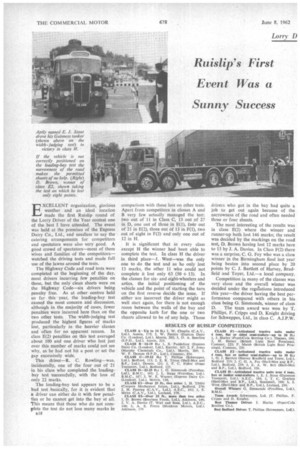Ruislip's First Event Was a Sunny Success
Page 44

If you've noticed an error in this article please click here to report it so we can fix it.
EXCELLENT organization, glorious weather and an ideal location made the first Ruislip round of the Lorry Driver of the Year contest one of the best I have attended. The event was held at the premises of the Express Dairy Co., Ltd., and needless to say the catering arrangements for competitors and spectators were also very good. A good crowd of spectators—most of them wives and families of the competitors— watched the driving tests and made full use of the lawns around the tests.
The Highway Code and road tests were completed at the beginning of the day, most drivers incurring few penalties on these, but the only clean sheets were on the Highway Code—six drivers being penalty free. As at other centres held so far this year, the loading-bay test caused the most concern and discussion, although in the majority of cases, fewer penalties were incurred here than on the two other tests. The width-judging test produced the highest figures of marks lost, particularly in the heavier classes and often for no apparent reason. In class E(2) penalties on this test averaged about 100 and one driver who lost just over this number of marks could not see why, as he had not hit a post or set the gap excessively wide.
This driver—R. C. Rowling—was, incidentally, one of the four out of 21 in his class who completed the loadingbay test successfully, with the loss of only 22 marks.
The loading-bay test appears to be a bad test basically, for it is evident that a driver can either do it with few penalties or he cannot get into the bay at all. This means that those who do not complete the test do not lose many marks in comparison with those lost on other tests. Apart from competitors in classes A and B very few actually managed the test: two out of 11 in Class C, 13 out of 27 in D, one out of three in E(1), four out of 21 in E(2), three out of 13 in F(1), two out of eight in F(2) and only one out of 12 in H.
It is significant that in every class except H the winner had been able to complete the test. In class H the driver in third place—I. West—was the only one to do the test and as he only lost 13 marks, the other 11 who could not complete it lost only 63 (50 + 13). In the classes for sixand eight-wheelers and artics, the initial positioning of the vehicle and the point of starting the turn on the first reverse decide the issue. If either are incorrect the driver might as well start again, for there is not enough room between the walls of the bay and the opposite kerb for the one or two shunts allowed to be of any help. Those drivers who got in the bay had quite a job to get out again because of the narrowness of the road and often needed three or four shunts.
The most interesting of the results was in class E(2) where the winner and runner-up both lost 146 marks; the result was decided by the markings on the road test, D. Brown having lost 12 marks here to 13 by J. A. Davies. In Class F(2) there was a surprise, C. G. Fey who was a class winner in the Birmingham final last year being beaten into second place by 20 points by C. I. Bartlett of Harvey, Bradfield and Toyer, Ltd.—a local company.
Competition in many of the classes was very close and the overall winner was decided under the regulations introduced this year—the driver having the best performance compared with others in his class being G. Simrnonds, winner of class D. The team award was won by T. Phillips, F. Cripps and D. Knight driving for Schweppes, Ltd., in class C. A.J.P.W.




































































































